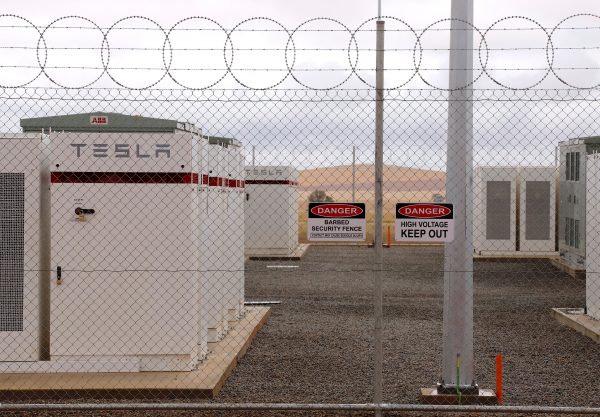South Australia is now on the world map after Tesla’s senior executive said the Australian state was “the future” for renewable energy technologies.
This comes as South Australia opened its first 12 out of 140 border-to-border electric car charging networks.
“Australia is a little bit of a special case; they represent the future—South Australia in particular—solar and wind supplied 70 percent of South Australia’s energy in 2022,” Andrew Baglino, Senior Vice President of Powertrain and Energy Engineering at Tesla, said at the company’s Investor Day event on March 1.
Baglino also referred to data gathered from 5000 customers in South Australia to tout the benefits of the company’s electrical products.
However, Baglino did not mention a court case in which, in 2021, the Australian Energy Regulator (AER) instituted proceedings against Hornsdale Power Reserve (HPR) for alleged breaches of the National Electricity Rules—where it was alleged that HPR failed to ensure frequency control between July and November 2019.
In 2016, Tesla created its first and then-biggest “Powerwall 2 batteries,” known as the Hornsdale Power Reserve, to power more than 5,000 South Australian homes. The system went into operation in November 2017 and was reported to have “a positive impact on the local network” in its first 100 days.

South Australia’s wind and solar energies are also reported to have the highest penetration of local grid demand in the world—which is favourable for the company’s plan to move towards renewables, reported Renew Economy.
The company has also used the “achievements” in South Australia to exponentially increase stationary battery storage to at least one terawatt-hour a year and beyond.
The Tesla big battery at the Hornsdale Power Reserve in South Australia costs around $172 million (US$116 million) and is capable of outputting 150 Megawatts for at most 77 minutes.
Musk Unveil’s Renewables Plan
Tesla’s Investor Day event in Texas was where CEO Elon Musk unveiled his company’s plan to become the leading global driver in shifting from fossil fuels to renewable energy. The plan, known as “Master Plan 3,” is expected to cost the company approximately $10 trillion.
“I really wanted today to be not just about Tesla investors who own stock, but really anyone who is an investor in Earth,” Musk said.
“There is a clear path to a sustainable-energy Earth. It doesn’t require destroying natural habitats. It doesn’t require us to be austere and stop using electricity and be in the cold or anything.”
Musk said Tesla plans to construct new car and battery cell factories and produce more cars per year at its existing factories.
Meanwhile, Tesla says South Australia has a key role in using battery storage to replace fossil fuels “one plant at a time,” where the company plans to ultimately reach a grid on 100 percent renewables.
“We have one grid operator that’s utilising virtual machine mode, and they say they will not operate their grid at 100 percent renewables unless they have this feature unless they have virtual machine mode working,” said Mike Snyder, the head of Tesla Megapack.
“They tried (without VMM), and it didn’t work very well. Virtual machine is like synthetic inertia where you turn the battery power plant … through software … into behaving like it’s a giant spinning machine, literally.
“And that inertia stabilises the grid. You don’t need a giant spinning machine. You don’t need a huge fossil fuel power plant or a giant hydro turbine.
“You just have the battery to it. And you can program it to whatever you need at that part of the grid. Or even have it be dynamically changing as the as the grid conditions change.”
Company Touts Cost Cost-Benefit of Electric Products
Baglino said the average monthly cost for its South Australian customers was $140.
But this cost was reduced to $61 per month if customers had solar, a Powerwall, and proposed software operations that worked in an “intelligent” way.
“That’s what happened in South Australia last year. This represents the future of South Australia, in particular, where solar and wind supplied 70 percent of South Australia’s energy in 2022,” Baglino said.
“That compares to 30 percent in Texas, and 35 percent in California, but this is an indication of where this is all headed in both centralised and distributed storage resources, providing the key to unlocking fully renewable grids.”
Meanwhile, Canstar Blue reported that the cost of purchasing a Tesla Powerwall 2 would be upwards of $15,000 (US$10,118), plus an additional $1000-$2000 for supporting hardware or installation.
Additionally, Choice reported that while some households may wait around eight years to recoup their investment, others may have to wait up to 20 years.
Economic Appeal Varies
Damien Moyse, CEO of Renew, a sustainability nonprofit, said that while solar with battery systems are economically attractive to Australian households, the appeal depends on location, household type, and energy usage, reported Choice.
“It’s fair to say more homes would now be able to achieve a 10-year payback [than in 2015], but a lot of homes still won’t,” he says. “The variation is huge … with larger, higher-usage houses getting better value out of a battery,” Moyse said.
Meanwhile, battery prices haven’t fallen as fast as solar panels, which fell less 95 percent in less than 10 years.
“While the cost of the battery technology has dropped significantly internationally, other costs associated with battery installation in Australia, including labour and other components, remain relatively expensive,” Moyse said.
Additionally, MarketWatch reports that while the Powerwall system has a larger capacity than most batteries currently on the market, it cannot be purchased separately via Tesla and is more expensive than other solar storage options.








